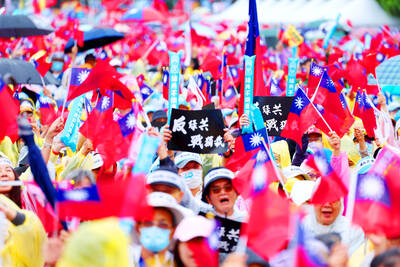The High Court yesterday revoked guilty verdicts against seven people involved in the occupation of the Executive Yuan during the 2014 Sunflower movement, as the charges against them have been dropped.
In April last year, the High Court sentenced the defendants to prison terms ranging from two to four months for inciting the occupation.
After an appeal, the Supreme Court in January remanded the cases to the High Court, saying that the defendants were exercising their “right of resistance,” or civil disobedience, as part of their freedom of expression.
The High Court yesterday said the role of the defendants in the occupation of the Executive Yuan complex had been redefined as assisting rather than inciting protesters, adding that the Executive Yuan had dropped its charges against the defendants and the cases have been closed.
The Sunflower movement was triggered by the then-ruling Chinese Nationalist Party (KMT) moving to fast-track a bill on a cross-strait services trade agreement with China.
During the protests from March 18 to April 10, hundreds of people broke into the Legislative Yuan, while thousands demonstrated outside the complex.
One group, which included the seven defendants, attempted to occupy the nearby Executive Yuan on March 23, but was forcibly removed by police wielding batons and firing water cannons during the early hours of March 24.
The defendants accused of inciting the Executive Yuan occupation were first tried in 2017 in the Taipei District Court, which acquitted them. Prosecutors appealed to the High Court, which last year overturned the lower court’s verdicts and found them guilty.
The High Court’s decision yesterday cannot be appealed.

PRAISE: Japanese visitor Takashi Kubota said the Taiwanese temple architecture images showcased in the AI Art Gallery were the most impressive displays he saw Taiwan does not have an official pavilion at the World Expo in Osaka, Japan, because of its diplomatic predicament, but the government-backed Tech World pavilion is drawing interest with its unique recreations of works by Taiwanese artists. The pavilion features an artificial intelligence (AI)-based art gallery showcasing works of famous Taiwanese artists from the Japanese colonial period using innovative technologies. Among its main simulated displays are Eastern gouache paintings by Chen Chin (陳進), Lin Yu-shan (林玉山) and Kuo Hsueh-hu (郭雪湖), who were the three young Taiwanese painters selected for the East Asian Painting exhibition in 1927. Gouache is a water-based

A magnitude 4.1 earthquake struck eastern Taiwan's Hualien County at 2:23pm today, according to the Central Weather Administration (CWA). The epicenter of the temblor was 5.4 kilometers northeast of Hualien County Hall, at a depth of 34.9 km, according to the CWA. The earthquake's intensity, which gauges the actual effect of a temblor, was the highest in Hualien County, where it measured 2 on Taiwan's 7-tier intensity scale. The quake also measured an intensity of 1 in Yilan county, Taichung, Nantou County, Changhua County and Yunlin County, the CWA said. There were no immediate reports of damage or injuries.

OFF-TARGET: More than 30,000 participants were expected to take part in the Games next month, but only 6,550 foreign and 19,400 Taiwanese athletes have registered Taipei city councilors yesterday blasted the organizers of next month’s World Masters Games over sudden timetable and venue changes, which they said have caused thousands of participants to back out of the international sporting event, among other organizational issues. They also cited visa delays and political interference by China as reasons many foreign athletes are requesting refunds for the event, to be held from May 17 to 30. Jointly organized by the Taipei and New Taipei City governments, the games have been rocked by numerous controversies since preparations began in 2020. Taipei City Councilor Lin Yen-feng (林延鳳) said yesterday that new measures by

‘WORSE THAN COMMUNISTS’: President William Lai has cracked down on his political enemies and has attempted to exterminate all opposition forces, the chairman said The legislature would motion for a presidential recall after May 20, Chinese Nationalist Party (KMT) Chairman Eric Chu (朱立倫) said yesterday at a protest themed “against green communists and dictatorship” in Taipei. Taiwan is supposed to be a peaceful homeland where people are united, but President William Lai (賴清德) has been polarizing and tearing apart society since his inauguration, Chu said. Lai must show his commitment to his job, otherwise a referendum could be initiated to recall him, he said. Democracy means the rule of the people, not the rule of the Democratic Progressive Party (DPP), but Lai has failed to fulfill his